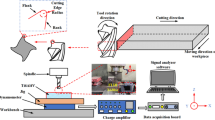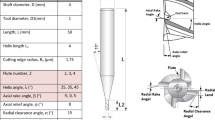Abstract
The influence of the cutting edge micro geometry on cutting process and on tool performance is subject to several research projects. Recently, published papers mainly focus on the cutting edge rounding and its influence on tool life and cutting forces. For applications even more important, however, is the influence of the cutting edge radius on the integrity of the machined part. Especially for titanium, which is used in environments requiring high mechanical integrity, the information about the dependency of surface integrity on cutting edge geometry is important. This paper therefore studies the influence of the cutting edge radius on surface integrity in terms of residual stress, micro hardness, surface roughness and optical characterisation of the surface and near surface area in up and down milling of the titanium alloy Ti–6Al–4V. Moreover, the influence of the cutting edge radius on burr formation is analysed. The experiments show that residual stresses increase with the cutting edge radius especially in up milling, whereas the influence in down milling is less pronounced. The influence of the cutting edge radius on surface roughness is non-uniform. The formation of burr increases with increasing cutting edge radius, and is thus in agreement with the residual stress tests.
Similar content being viewed by others
References
Biermann D, Terwey I (2008) Cutting edge preparation to improve drilling tools for HPC processes. CIRP J Manuf Sci Technol 1(2):76–80
Terwey I (2008) Leistungssteigerung bei Zerspanwerkzeugen durch Kantenpräparation. Zerspanen im modernen Produktionsprozess, Fachgespräch zwischen Industrie und Hochschule, 26.2.-27.2. 2008, Dortmund (eds. K. Weinert, D. Biermann)
Wyen C, Wegener K (2010) Influence of cutting edge radius on cutting forces in machining titanium. Ann CIRP 59(1):93–96
Ozturk S, Altan E (2012) A slip-line approach to the machining with rounded-edge tool. Int J Adv Manuf Technol, pp. 1–10. doi:10.1007/s00170-012-3941-6
Outeiro JC (2010) Size-effects and surface integrity in machining and their influence on product sustainability. Int J Sustain Manuf 2(1):113–126
Rech J (2006) Influence of cutting edge preparation on the wear resistance in high speed dry gear hobbing. Wear 261:505–512
Cortés Rodríguez CJ (2009) Cutting edge preparation of precision cutting tools by applying micro- abrasive jet machining and brushing. Dissertation, Kassel University
Wang X, Huang C, Zou B, Liu H, Wang J (2012) Effects of geometric structure of twist drill bits and cutting condition on tool life in drilling 42CrMo ultrahigh-strength steel. Int J Adv Manuf Technol. doi:10.1007/s00170-012-4026-2
Elsharkawy M (1975) Einfluss des Ecken- und Schneidkantenradius auf die Oberflächengüte beim Feindrehen. Fertigungstechnik Betrieb 25(4):230–233
Betz F (1971) Untersuchungen zur Entstehung der Schnittflächenrauheit bei der spanenden Bearbeitung. Dissertation, ETH Zurich
Kötter D (2006) Herstellung von Schneidkantenverrungdungen und deren Einfluss auf das Einsatzverhalten von Zerspanwerkzeugen. Dissertation, Dortmund University
Byelyayev O (2008) Erhöhung der Leistungsfähigkeit von HSS-Spiralbohrern durch Einsatz der magnetabrasiven Bearbeitung. Dissertation, Technical University Magdeburg
Xu G (1996) Einfluss der Schneidkantenform auf die Oberflächenausbildung beim Hochgeschwindigkeitsfräsen mit Feinkornhartmetall. Dissertation, TU Darmstadt
Weinert K, Kötter D, Kresing I (2006) Präparierte Werkzeugschneidkanten optimieren das Schnittverhalten. MM Maschinenmarkt 50:22–25
Denkena B, Friemuth T, Spengler C, Weinert K, Schulte M, Kötter D (2003) Kantenpräparation an Hartmetall-Werkzeugen. wt Werkstattstechnik online 93(3):202–207
Kreis W (1973) Verschleissursachen beim Drehen von Titanwerkstoffen. Dissertation, RWTH Aachen Technical University
Altmüller S (2000) Simultanes fünfachsiges Fräsen von Freiformflächen aus Titan. Dissertation, RWTH Aachen Technical University
Field M, Kahles JF (1964) The surface integrity of machined and ground high strength steels. DMIC Report 210:54–77
Stephenson DA, Agapiou JS (2006) Metal cutting theory and practice. CRC Press, Boca Raton
Lucca DA, Brinksmeier E (1998) Progress in assessing surface and subsurface integrity. Ann CIRP 47(2):669–693
Wyen C, Wegener K (2010) Experimental study of micro abrasive jet machining for the generation of rounded cutting edges on cemented carbide tools. 8th International Conference on High Speed Machining, Metz, France, pp. 367–373
Wyen C, Wegener K (2011) A new method for the characterisation of rounded cutting edges. Int J Adv Manuf Technol 59(9–12):899–914
Eigenmann B, Macherauch E (1995) Röntgenographische untersuchung von spannungszuständen in werkstoffen–Teil III. Mat-wiss Werkst 27:426–437
Birkholz M (2006) Thin film analysis by X-ray scattering. Wiley, Weinheim
Prevéy PS (1986) X-ray diffraction residual stress techniques In: Metals handbook. American Society for Metals, Metals Park, pp. 380–392
Noyan IC, Cohen JB (1987) Residual stress—measurement by diffraction and interpretation. Springer, New York, pp 164–210
DIN EN ISO 4288 (1998–04) Geometrische Produktspezifikation (GPS)-Oberflächenbeschaffenheit: Tastschnittverfahren-Regeln und Verfahren für die Beurteilung der Oberflächenbeschaffenheit. German Institute for Standardization, Berlin
Davim JP (2010) Surface integrity in machining. Springer, London
Albrecht P (1960) New developments in the theory of the metal-cutting process. Part 1: the ploughing process in metal cutting. ASME J Eng Ind 81:348–358
Scholtes B (1990) Eigenspannungen in mechanisch randschichtverformten Werkstoffzuständen, Ursachen, Ermittlung und Bewertung, Habilitation, TH Karlsruhe
L’VOV NP (1969) Determining the minimum possible chip-thickness. Mach Tool 40(4):45–46
Denkena B, de León-García L, Köhler J (2005) Bearbeitungsinduzierte Eigenspannungen beim Fräsen von Aluminium und Titan, Neue Fertigungstechnologien in der Luft- und Raumfahrt, Seminar, Hannover (23–24 November)
Klein H-D (1969) Eigenspannungen und ihre Verminderung in metallischen Werkstücken durch spanende Bearbeitung. Dissertation, TU Hannover
Tosha K (2002) Influence of residual stresses on the hardness number in the affected layer produced by shot peening. 2nd Asia-Pacific Forum on Precision Surface Machining and Deburring Technology, Seoul, Korea (July) pp. 48–54
Frankel J, Abbate A, Scholz W (1993) The effect of residual stresses on hardness measurements. Exp Mech 33(2):164–168
Martellot M (1941) Analysis of the milling process. Trans ASME 63:677–700
Qu J, Shih AJ (2003) Analytical surface roughness parameters of a theoretical profile consisting of elliptical arcs. Mach Sci Technol 7(2):281–294
Brammertz PH (1961) Die entstehung der oberflächenrauheit beim feindrehen. Ind-Anz 2:25–32
Weule H, Hüntrup V, Tritschler H (2001) Micro-cutting of steel to meet new requirements in miniaturization. Ann CIRP 50(1):61–64
Son SM, Lim HS, Ahn JH (2009) Effects of the friction coefficient on the minimum cutting thickness in micro cutting. Int J Mach Tool Manuf 45:529–535
Nakayama K, Arai M (1987) Burr formation in metal cutting. Ann CIRP 36(1):33–36
Gillespie LK, Blotter PT (1976) The formation and properties of machining burrs. Trans ASME, J Eng Ind 98:66–74
Hashimura M, Hassamontr J, Dornfeld DA (1999) Effect of in-plane exit angle and rake angles on burr height and thickness in face milling operation. Trans ASME, J Manuf Sci Eng 121(February):13–19
D. Dornfeld, S. Min (2010) A review of burr formation in machining. In: Burrs—analysis, control and removal. Springer, Berlin, pp. 3–11
Rangaswamy P, Prime MB, Daymond M, Bourke M, Clausen B, Choo H, Jayaraman N (1999) Comparison of residual strains measured by X-ray and neutron diffraction in a titanium (Ti-6Al-4V) matrix composite. Mater Sci Eng A259:209–219
Halevy I, Zamir G, Winterrose M, Sanjit G, Grandini CR, Moreno-Gobbi A (2010) Crystallographic structure of Ti-6Al-4V, Ti-HP and Ti-CP under high-pressure. J Phys Conf Ser 215:012013
Author information
Authors and Affiliations
Corresponding author
Rights and permissions
About this article
Cite this article
Wyen, CF., Jaeger, D. & Wegener, K. Influence of cutting edge radius on surface integrity and burr formation in milling titanium. Int J Adv Manuf Technol 67, 589–599 (2013). https://doi.org/10.1007/s00170-012-4507-3
Received:
Accepted:
Published:
Issue Date:
DOI: https://doi.org/10.1007/s00170-012-4507-3




